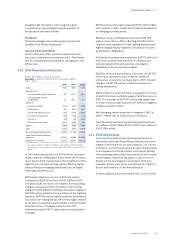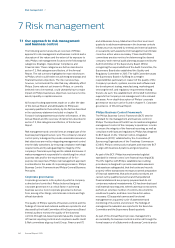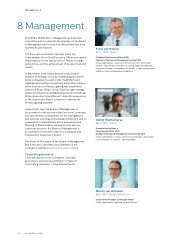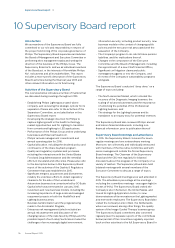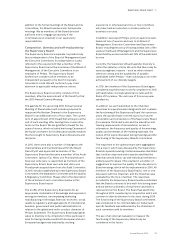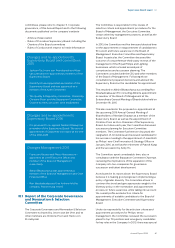Philips 2015 Annual Report Download - page 72
Download and view the complete annual report
Please find page 72 of the 2015 Philips annual report below. You can navigate through the pages in the report by either clicking on the pages listed below, or by using the keyword search tool below to find specific information within the annual report.Risk management 7.6
72 Annual Report 2015
of goods and services, tax uncertainties related to
acquisitions and divestments, tax uncertainties related
to the use of tax credits and permanent establishments,
tax uncertainties due to losses carried forward and tax
credits carried forward and potential changes in tax law
that could result in higher tax expense and payments.
Those uncertainties may have a signicant impact on
local tax, results which in turn could adversely aect
Philips’ nancial condition and operating results.
The value of the losses carried forward is subject to
having sucient taxable income available within the
loss-carry-forward period, but also to having sucient
taxable income within the foreseeable future in the
case of losses carried forward with an indenite carry-
forward period. The ultimate realization of the
Company’s deferred tax assets, including tax losses and
credits carried forward, is dependent upon the
generation of future taxable income in the countries
where the temporary dierences, unused tax losses
and unused tax credits were incurred and during the
periods in which the deferred tax assets become
deductible. Additionally, in certain instances,
realization of such deferred tax assets is dependent
upon the successful execution of tax planning
strategies. Accordingly, there can be no absolute
assurance that all (net) tax losses and credits carried
forward will be realized.
For further details, please refer to the tax risks
paragraph in note 8, Income taxes.
Philips is exposed to uncertainty on the timing and
proceeds of a sale of Lumileds.
On January 22, 2016 Philips announced the termination
of its agreement with GO Scale Capital to sell a stake of
80.1% in Lumileds due to the inability to mitigate
regulatory concerns in the US. Philips is engaging with
other parties that have expressed an interest in the
Lumileds business. Adverse market conditions during
the bidding and sale process and regulatory restrictions
may have an adverse eect on the timing of a sale
transaction and the potential proceeds from such a
transaction. Prolonged adverse conditions could trigger
a requirement to no longer classify Lumileds as being
held for sale and being reported as discontinued
operations. This would have a material impact on the
balance sheet and EBITA as reported by Royal Philips.
Philips has dened-benet pension plans and other
post-retirement plans in a number of countries. The
funded status and the cost of maintaining these plans
are inuenced by movements in nancial market and
demographic developments, creating volatility in
Philips’ nancials.
A significant proportion of (former) employees in Europe and
North and Latin America is covered by defined-benefit
pension plans and other post-retirement plans. The
accounting for such plans requires management to make
estimates on assumptions such as discount rates, inflation,
longevity, expected cost of medical care and expected rates
of compensation. Movements (e.g. due to the movements
of financial markets) in these assumptions can have a
significant impact on the Defined Benefit Obligation and net
interest cost. A negative performance of the financial markets
could have a material impact on cash funding requirements
and net interest cost and also affect the value of certain
financial assets and liabilities of the company.
Philips is exposed to a number of reporting risks.
A risk rating is assigned for each risk identified, based on the
likelihood of occurrence and the potential impact of the risk
on the financial statements and related disclosures. In
determining the probability that a risk will result in a
misstatement of a more than inconsequential amount or
material nature, the following factors are considered to be
critical: complexity of the associated accounting activity or
transaction process, history of accounting and reporting
errors, likelihood of significant (contingent) liabilities arising
from activities, exposure to losses, existence of a related
party transaction, volume of activity and homogeneity of the
individual transactions processed and changes to the prior
period in accounting characteristics compared to the
previous period.
For important critical reporting risk areas identied
within Philips we refer to the “Use of estimates” section
in note 1, Signicant accounting policies, as the
Company assessed that reporting risk is closely related
to the use of estimates and application of judgment.
7.7 Separation risk
Philips is exposed to risks associated with the
separation of its Lighting business.
In September 2014 Philips announced its plan to
sharpen its strategic focus by establishing two stand-
alone companies focused on HealthTech and Lighting
opportunities respectively. This is a complex process
which involves certain risks to Philips. Although a stand-
alone structure for Philips Lighting was established on
February 1, 2016, there are still a number of important
milestones to be completed in the separation process.
Philips is reviewing all strategic options for Philips
Lighting, including public oerings of ownership stakes
and a private sale. The completion could take more time
than originally planned or anticipated. There is no
certainty as to the method or timing of the separation,
which may expose Philips to risks regarding the
proceeds from a sale of Philips Lighting, additional
costs and other adverse consequences.
The separation into Royal Philips and Philips Lighting is
unlike divestments or carve out transactions that Philips
has implemented in the past, which aected very
specic parts of the business of Philips. The separation
impacts all businesses and markets as well as all
supporting functions and all assets and liabilities of the
Group and will continue to require complex and time
consuming disentanglement eorts.



